 |
  |
 |
  |
History of Evolution of Odissi Dance after Independence - Dr. Ileana Citaristi e-mail: icitaris@gmail.com June 5, 2024 ODIA THEATRE The emergence of the Odia theatre scene in the early forties marked the end of the different forms of rasleelas or musical plays as forms of independent representations and they became part of the repertoire of theatre groups along with other plays based on modern or mythological subjects. Many of the artistes who were involved in the leelas shifted to the newly opened theatre groups so that a certain continuation in the tradition could be maintained and the more popular libretto of the leelas continued to be represented even if in a more secular environment. One of the earliest theatre groups which opened at Cuttack in 1918, was the Radha Krishna Theatre followed by others like Hajuri Theatre at Puri, New Theatre of Odisha at Baripada, Odisha Theatres at Cuttack, Bhagwati Theatres at Banapur on the Chilka Lake and the three Annapurna Theatres opened by the same proprietors-Somnath Das at Puri, Annapurna A, Cuttack, Annapurna B and Berhampur, Annapurna C. 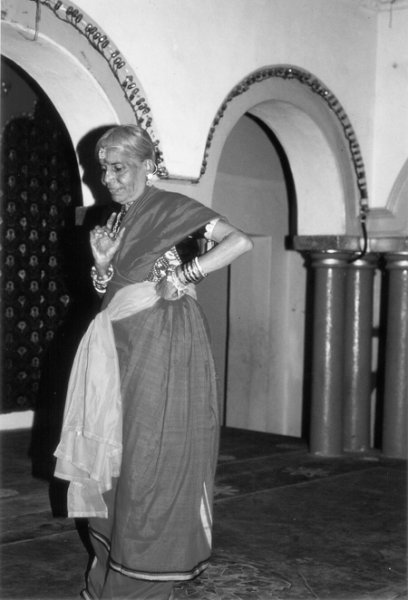 Shashimani Mahari (Photo: Ileana Citaristi) Kalicharan Patnaik, a stalwart in the history of Odia literature and performing arts, started his Krishna leela troupe called Sakhi Gopal Natya Sangha in the early thirties giving performances both in Puri and Cuttack. The performing unit included boys and females who were trained in the gotipua style of dance by Mohan Mohapatra, one of the most renowned dance masters of Puri during those times and in the mahari style by Singari Shyam Sundar Kar, the doyen of Odissi music, who later on became associated with the first dance and music association opened at Cuttack in 1933, the Utkal Sangeet Samaj. In 1939, the Sakhi Gopal Natya Sangha was converted into the Odisha Theatres and most of the artistes continued to be associated with it; among them we find names such as Harihar Rout, Durlav Chandra Singh, Mayadhar Raut, Kelucharan Mohapatra who played an important role in the establishment of dance as an independent art form in the subsequent years. Apart from the gotipua and rasleela traditions, the other two forms of dance which got assimilated with the theatre movements in the early forties were the Dakhina Nata or Sakhi Nata prevalent in the southern part of Odisha and the Chhau Nata which originated in the Mayurbhanj district and got associated with the New Theatre of Odisha where Deba Prasad Das and Pankaj Charan Das, two other pioneers of the dance revival in the fifties, spent few years as actors and dance masters. It is interesting to note how in the course of a few years, almost all these artistes converged in the two Annapurna theatres A and B opened at Puri and Cuttack respectively and especially in this second one which got its permanent location at Buxi Bazaar at Cuttack in 1945. Under the direction of Lingaraj Nanda, a very enterprising and creative man, always ready to experiment with new ideas, the talented group of actors which formed the Annapurna B group, were able to stage in the course of a few years, a series of acclaimed theatre productions which brought about a cultural revolution in the history of Odia performing arts. The Annapurna B group was formed by enterprising personalities all equally talented in their own artistic sphere of action. The manager Lingaraj Nanda, originally from Balugaon, had been exposed in his childhood to gotipua and Dakhina Nata in his own village and being very fond of dance, after shifting to Cuttack had assembled a group of boys and girls from the nearby villages and had entrusted Pankaj Charan Das with the task to teach them whatever at that point of time was known as nacha. 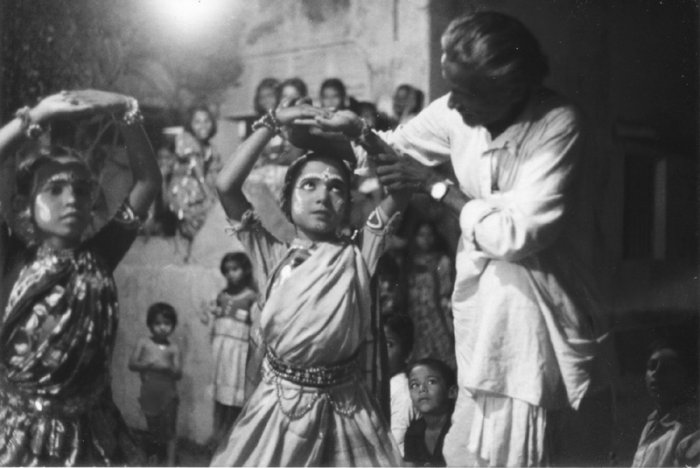 Gotipua or Akhada pila (Puri 1981) (Photo: Ileana Citaristi) Young Pankaj Charan, originally from Puri, had been exposed in his childhood to the practice of the mahari dance in the house of his maternal aunt Ratnaprabha mahari and of the gotipua dance taught in the pathara akhada by Jagu Mohanty. Subsequently, he had been part of the rasleela troupes of Ranganath Dev Goswamy and Bikhari Charan Dalei before being engaged in different roles as actor and dance master in the Hajuri Theatre directed by Balabhadra Hajuri Kuntia operating near the Loknath Temple in Puri and the New Theatre of Odisha operating at Baripada under the direction of Radharamana Ray, where he had the opportunity to be exposed to the Chhau Nata style of dance. With his vast exposure to a variety of dance traditions, Pankaj Charan, then in his early twenties, was considered at that time one of the best candidates for teaching a sort of dance which could be eventually utilized in the context of a dramatic plot. The group of actors, who left Kalicharan Patnaik's Odisha Theatres for disagreement on monetary matters with the master and formed the main core of the B group, included Samuel Sahoo Babi, Priyanath Mishra, Madhu Polei, Bipin Patnaik, Krishna Chandra Pande, Kashinath Sahu, and a few others. Among them Durlav Chandra Singh, a native of Puri, had been the last one to come away from Kalicharan Patnaik when all the others decided to leave. He had been with the master for nineteen years from the age of eleven and he was like a son to him. After eight years of experience in the rasleela troupe directed by the master, he became a multitasked member of the new theatre group in charge of all sorts of activities related to the functioning of the troupe. His long association with Kalicharan allowed him to be exposed to dance, poetry, music, literature and to absorb and observe from the frequent discussions and demonstrations held among the poets, musicians and dramatists who met regularly at Kalicharan's house. Being prevented from dancing due to the frequent attacks of rheumatic fever which would leave his joints weak, he specialized in music and percussion and became an adept player of khol, tabla and drupad pakhawaj. At the age of 29 he and his wife, a dancer and actress of the same group, decided to join the others who had already formed the B group and became one of the leading musicians and dramatists of the troupe. Kelucharan Mohapatra had been picked up by Samuel Sahoo Babi while he was returning to his village Ragurajpur from Puri where he was at that time directing his own rasleela group called Radhakanta Rasa Party, which used to perform on a makeshift pandal built on the bada danda (main road) just opposite the building where the Annapurna A group was operating. Kelucharan was known to Samuel and also to Durlav for having worked for a little less than one year in the Odisha Theatres doing all sorts of jobs from loading and unloading scenes, doing make-up of the main artistes, singing, playing the tabla and helping to arrange the stage sets. When Samuel introduced him to Lingaraj Nanda, he recommended him as 'a good tabla player' so he was kept on trial for a month during which he was given only food and lodging. From the second month he started receiving Rs 15 per month. In spite of his long association with Mohansundar Dev Goswamy, with whom he had stayed for twelve years and having played all the roles in the Krishna leela including Krishna for which he became quite famous, Kelucharan was still hesitating to disclose his past experience as a dancer and preferred to be known as a percussionist, probably still remembering the contempt which his father had expressed towards dance during his childhood. 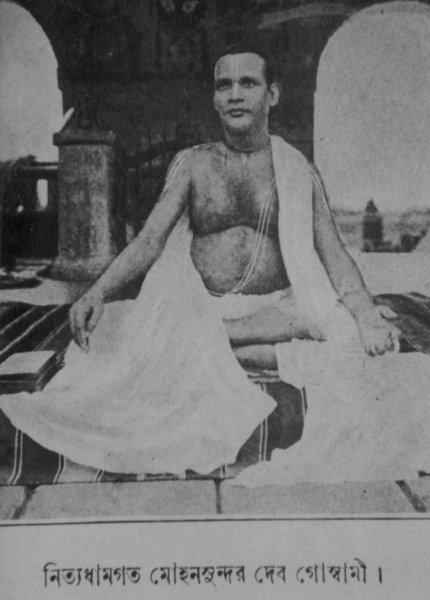 Mohansundar Dev Goswamy (archive photo) Lingaraj Nanda had started to introduce short dance sequences as curtain raisers before the main play which would be composed by Pankaj with simple and stylized movements. When the group started the rehearsals for the mythological play Devi, written by Ramachandra Mishra, the director Samuel Sahoo Babi suggested that some scenes of the nataka could be rendered through dance. The story, based on the mythological plot of the victory of Mohini over the demon Bhasmasura, required three main characters, one female and two males. The female dancer for the part of Mohini had not yet been chosen; Pankaj Charan assigned the role of Mahadev to Kelucharan and kept for himself the role of Bhasmasura. Lingaraj Nanda went to Puri and brought back from the A group the star dancer Lakshmipriya, who along with her stepmother, was residing in the Annapurna Theatre complex almost since its inception. She was immediately selected for the role of the temptress Mohini and in about seven days, the fifteen minutes dance-drama was ready to be presented.. Both the dance sequences, the one based on a tala of ten matra danced by Mahadeva and the one performed by Mohini in sixteen matra were composed by Pankaj Charan Das and although they could not as yet be classified under any particular style, they certainly created history. 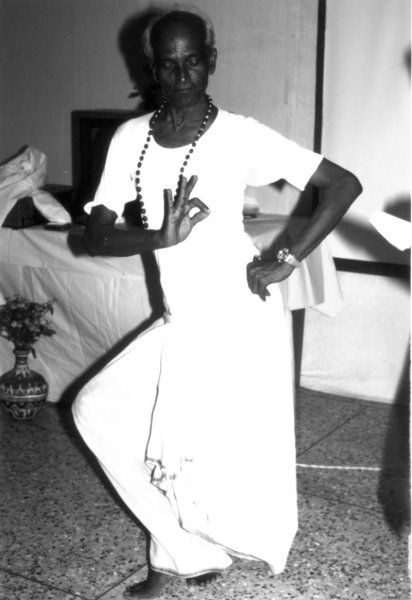 Pankaj Charan Das (1986) (Photo: Ileana Citaristi) It was during the making of these sequences that the aptitude of Kelucharan towards dance was revealed and from now onwards his direction in life took a definitive turn. The play gave the opportunity to Lakshmipriya to reveal her exceptional talent and stage presence. Having been groomed in the theatre atmosphere of the A group since she was seven, she had learnt whatever folk and tribal dances were being taught over there and she had already taken part as an actress in a few plays staged at Puri by that group. Following the success of this first experiment, Lingaraj Nanda called a gotipua master from Puri to teach her two Odia songs in the gotipua style. She got the chance to present one of the song, 'nahi ki k oridela' ('the one who denied') in the next play Abhisek, written by Aswini Kumar Ghosh. The script dealt with the coronation of a Puri king and the dance sequence was inserted at the commencement of the play with musical accompaniment provided on mardala by Kelucharan and harmonium by Harihar Rout. The effect on the audience was stunning; it was perhaps for the first time that a female dancer was presenting a solo item of dance on stage. It was by seeing her dance performance on stage that the first students from well-to-do families came forward to learn dancing in the early fifties notwithstanding the bad reputation that was still lingering over it. Most of the female dancers attached to the theatre groups were from the mahari families and had to bear the burden of the stigma that colonial mentality and reformistic attitude of the section of Indian society educated according to Western moral values had attached to their communities. One has to give credit to individuals like Kavichandra Kalicharan Patnaik, Bauri Bandhu Mohanty, the manager of A group, Lingaraj Nanda, and others alike if dance not only survived but also got its right place among the performing arts of those days paving the way for its total redemption in the post-Independence era. The success of these two ventures gave the management of the B group enough confidence to proceed in the same direction and to consider the dance element as an important component of the dramatic presentation. When towards the end of 1946, rehearsals for the new drama Sadhava Jhia (The Merchant's Daughter) started, all the directors agreed on having a dance item inserted in the plot. The story is about the legendary Tapoi and her seven brothers who leave her behind with their wives to sail across the sea to the distant islands of Java and Sumatra to sell their merchandise. It was decided that in order to draw the Balinese people towards buying their products which included among others patachitra and textiles depicting Hindu gods and goddesses, the merchants would perform an item of dance which would best represent the essence of Odia culture. 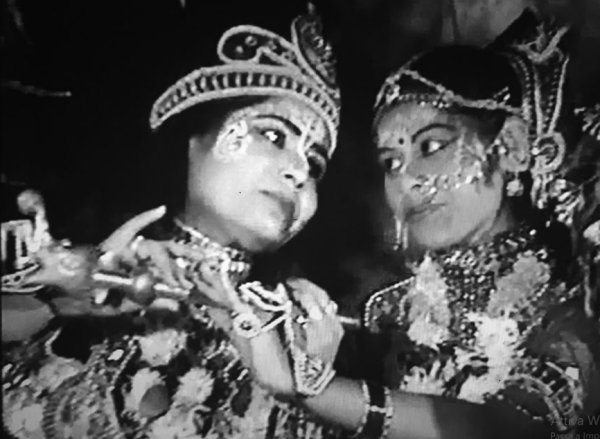 Rasleela-Bana Bihari by Durlav Chandra Singh troupe (1998) (Photo: Ileana Citaristi) Durlav Chandra Singh suggested that the opening invocation of the Geeta Govinda, the Dashavatar poem depicting the ten incarnations of lord Vishnu, could be composed for the purpose. Not only it would be dramatically and thematically attractive but it would also be the right choice for symbolizing in a nutshell centuries of Odia cultural history. Durlav used to sing the lyric while acting as Jayadeva in the Jayadeva nataka staged by Kalicharan Patnaik troupe in 1943. After discussion, it was decided to keep the same tala of 10 beats and the same raga Chandrakant of the previous composition also for the choreographed version. What emerged was a result of the combined efforts of all of the people involved, each contributing in his own capacity to make what was later to be defined as an historical event in the evolution of Odissi dance. Durlav was present not only as director of the entire play but also as dance teacher and pakhawaj and tabla player, Pankaj Charan as dance master, Kelucharan as dancer and percussionist, Harihar Rout and Madhu Polei as music masters, Lingaraj Nanda and Advaita Charan Mohanty, the writer of the play, as coordinators and advisers. While poses and body postures to depict each avatar could be taken from sculptural and pictorial evidences, none of the people involved had yet been acquainted with any shastric text depicting the specific hasta mudra (hand gestures) to be used to distinguish one avatar from the other. Under Durlav's suggestion a book titled 'Dances of India' authored by Projesh Bannerjee containing drawings and descriptions of the different mudras was bought from Kolkata and for the first time in Odisha, a dance sequence came to be composed following the guidelines of a written text. On the rhythmic score provided by Durlav, Harihar and Kelucharan, Pankaj Charan and Durlav composed the dance sequences assisted by Lingaraj and Advaita Mohanty in understanding the meaning of the Sanskrit shloka. The two dancers were Kelucharan and Lakshmipriya with the first one taking a prominent role in the abhinaya portions of the dance item. The composition included alternating sequences of nritya where the different avatars were introduced through the enactment of the meaning of the respective shloka through hand gestures and facial expressions and rhythmic interludes where appropriate nritta sequences were performed to suit the character of each avatar. During the nritya portions, Lakshmipriya was mostly standing with anjali hasta (joined hands) turned towards Kelucharan in the role of a bhakta (devotee), whereas the rhythmic sequences were executed by both the dancers together. The basic structure of the dance composition has remained more or less the same until today with the rhythmic score composed by Durlav in drupad style converted into the bani (mnemonic syllables) of the Odissi pakhawaj by Kelucharan. For example, the initial sequence in the original composition had the following rhythmic score: Dha tette dage kruda tette Ta tette dage kruda tette Dheredhere kintaka dhei dhei taka Dhuma kita dhum kita taka Taka dhum dhum kita taka. The same converted into the Odissi bani became: Ta atti nakadataka dhina kette Ta atti nakadataka dhinna kette Dheitere ketetaka dhei dhei ta Tatin nam ta tatin nam Tatin nam ta tatin nam. After the success of this experiment, the dance scenario in the B group got a further burst by the presence of another dance master, Dayal Sharana, who, soon after the staging of the Sadhava Jio nataka, came to Cuttack along with his troupe to present his dance repertoire at the Annapurna B theatre. While his performances did not seem to attract enough public, his decision to stay over and teach the Uday Shankar style of dance to the dancers of the theatre group turned out to be an enriching and unique experience for all of them. In the initial phase of his permanence was Kelucharan, who took the maximum advantage from Dayal's teachings and put immediately into action the newly acquired experience in the compositions of the dance items for the subsequent play Aloka, for which he composed a dance piece in three different styles, Manipuri, Odissi and Kathak. For the following play Nara Devata, he composed a group dance and for the Upendra Bhanja nataka he composed an abhinaya to the famous song 'Kanto bina diba rajani sajani' ('without my husband days and nights appear very long') combining both the mahari and gotipua styles. In the words of Kelucharan: "Dayal Sharana showed me the way; he made me conscious of what my body was doing and what more could be achieved through exercises. He made me aware of the use of the different mudras of the hands and of the possibilities of utilizing the same hand gestures for expressing different actions. He taught me how to compose small sequences of dance by putting together different steps; he opened in front of me the door of creativity and once I went beyond its threshold I never had to look back." After Kelucharan and Pankaj departed from the B group, the dance items composed by them continued to be performed by the dancers of the group either independently or as part of the plays. In the early fifties, the other two future stalwarts of the Odissi dance revival joined the group, Mayadhar Raut and Deba Prasad Das, and both of them got enriched by the teachings of Dayal Sharana, who kept on visiting the theatre at intermittent intervals from his native place in Andhra Pradesh. The time was now mature for the dance scene to acquire its independent identity, to emerge from all the different streams by which it had been nurtured and to assume a unique and distinctive place of its own. THE REVIVAL The introduction of dance items in the theatre repertoire provoked a new interest towards this art among the so-called 'upper class' families. Parents started wanting their small daughters to be trained in dance and they began to take pride in seeing them competing in dance functions or in cultural events linked to some festivities. Dance masters were commuting by cycle at times covering distances of quite a few kilometres to travel between one assignment and another. With the theatre experience at their back, besides teaching whatever dance was available at that point of time, they were improvising themselves also as costume designers, make-up artistes and music accompanists all in one. The first institutions to be opened at Cuttack were Utkal Sangeet Samaj which started in 1933 and National Music Association in 1943. The first years they were dedicated to the teaching of music but soon dance became an additional subject. Master Bono Bihari Maity, Master Chinmoy Lahiri and Master Ram Gopal Krishna all from Bengal, came to Odisha to teach Kathak dance, the first one at the Utkal Sangeet Samaj, the second at the National Music Association and the third one at the Kala Vikash Kendra, the third institution to be opened in Cuttack in 1952. Master Bono Bihari Maity used to teach also a dance style which people referred to as 'bangla nacha', a mixture of Manipuri and Uday Shankar style. He had also taught a dance piece on Shiva at the Annapurna B group. Due to the absence of proper training in Odisha, in 1954, the Utkal Sangeet Natya Kala Parishad announced a government scholarship which was offering the possibility to learn dance and music in some of the major institutions of the country, such as Santiniketan in Bengal founded by Rabindranath Tagore and Kalakshetra in Chennai founded by Rukmini Devi Arundale. Among the thirty or so contestants who appeared for the audition, six people were awarded, among whom Mayadhar Raut, Minati Mishra and Sanjukta Panigrahi, chose to study Bharatanatyam at Chennai. For the audition, Mayadhar Raut danced the Dashavatar item the way he had learned it in the B group. In the meantime, the cultural scene at Cuttack was getting more and more lively and vibrant and the young girls, who had started learning, although still in their teens, were getting opportunities to exhibit themselves in one or the other of the dance competitions which were becoming more numerous day by day. In the initial phase, the dance items the girls were presenting were the ones composed for the stage plays further refined and embellished by the respective dance masters and made more suitable as dance presentations. In May 1953, little Sanjukta presented 'Nahi ki koridela' in the annual function of the Children's Little Theatre at Kolkata, the same song for which Lakshmipriya had become famous on the Annapurna B stage. Little Minakhi Nanda became famous for her dance of Shiva Nataraja which Kelucharan reworked on the basis of the one performed by him in the Devi Basmasura play. The special features of the item were the difficult acrobatic poses of the first part and the special effects of coloured lights and gunpowder which accompanied the tandava portion. In April 1954, Sadhana Bose, one of the first students to get admitted in the Kala Vikash Kendra, got the first position in Odissi, Manipuri and Bharatanatyam in the age group below 12 years in the dance and music competition organized by the Nikhil Utkal Music Conference at Cuttack and in the same year she won a gold medal at Kolkata by presenting the Dashavatar item during the Vasant Utsav celebration at the Indian Association Hall. The same Dashavatar was being presented on many occasions both as solo and as duet dance. Mayadhar Raut besides performing it for the scholarship audition, danced the same item in partnership with Lakshmipriya for the inaugural function of the Odisha High Court at Cuttack and Dhirendranath Patnaik for his performance at the First Inter University Youth Festival at Delhi in November 1954. 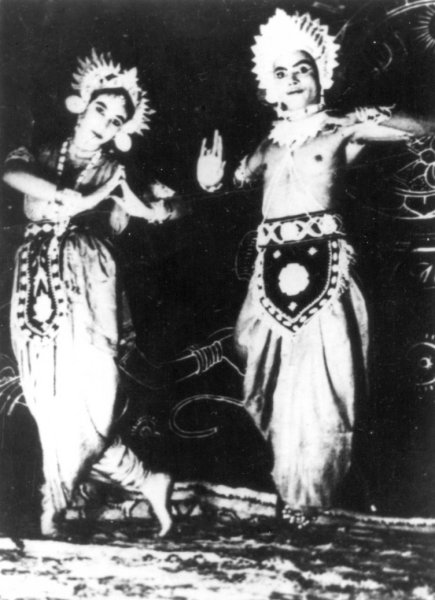 Kelucharan Mohapatra and Lakshmipriya in Dashavatar (1947) (courtesy Srjan collection) On the same occasion, Priyambada Mohanty presented a short sequence of abhinaya based on the song 'Gumana kahinkire' ('Why this false pride?') composed for the occasion by Kalicharan Patnaik and taught to her and conducted by Deba Prasad Das. The occasion is written down in the annals of Odissi dance as the first step towards the recognition of the style as one of the classical styles of Indian dance. Priyambada Mohanty had been introduced into dance by Singhari Shyamsunder Kar, an eminent musician and percussionist considered to be the doyen of Odissi music. Popularly known as Singhari, he belonged to a family which was in charge of the bada singhara besha of Lord Jagannath in the evening time. This gave him the advantage of being exposed to the rituals and to the rendition of the singing of Geeta Govinda by the mahari in the temple and to be immersed in the cultural atmosphere of Puri of the first half of the last century which was pulsating with dance and music taught in the akhada and exhibited in the performances by the various rasleela and theatre groups. With a strong foundation in Odissi and Hindustani music and percussion which he learnt from local as well as visiting eminent musicians, he became a reference point for the composition of music and dance items undertaken by the different theatre groups as well as music institutions. According to Dayanidhi Das, another master associated with the Kala Vikash Kendra since its inception, the initial rhythmic bols of the Batu Nrutya, 'ta kadataka dhi kadataka ta dhi kadataka jhe ketetaka jhe jhenam ta ta', were collected by him and Kelucharan from Singhari. He also acknowledges to have consulted Singhari for the draft of the first syllabus of music and dance that he drew for the Kala Vikash Kendra in 1954. Although Odissi was invited to participate by the Sangeet Natak Akademi in the All India Dance Seminar in Delhi in April 1958, at this point it was not yet accepted as 'classical' dance form but only as 'traditional' by the Akademi. Discussions in Parliament followed for about two years after this with delegates from Odisha trying to get the 'classical' status approved by the Ministry and the Ministry deferring the decision to the Expert Committee nominated by the Akademi. There is no final evidence about the exact date when the approval was given (if at all a definite date exists) but in general it has been accepted that the Sangeet Natak Akademi Award conferred on Kelucharan Mohapatra in 1966 can be regarded as the final date. The opening of the All India Radio at Cuttack in 1948 under the dynamic direction of P.V. Krishnamurty resulted in a further growth of the dance scenario. Krishnamurty has been responsible in bringing together three leading musicians under the same roof, Balakrishna Das from Puri, Bhubaneswar Mishra from Ganjam and Hariprasad Chaurasia from Uttar Pradesh. The collaboration between these eminent musicians and a group of talented script writers and directors such as Govind Tej, Nilamadhav Bose, Suren Mohanty, Kalicharan Patnaik, Nayan Kishor Mohanty and Anada Charan Das generated a revolution in the field of music and dance drama productions in the fifties. Many of the dance dramas presented on the occasion of the Kumar Utsava, a festival organized annually at Cuttack from 1952 onwards by the Kumar Utsav Samiti, were broadcast live by the All India Radio giving for the first time proper names and credits to the participating artistes before each broadcast. Music directors, writers, dance masters and musicians would assemble and discuss about the theme, dancers would be recruited from different institutions, funds would be collected and rehearsals would be carried on in full swing in an atmosphere of collaboration and enthusiasm among all the participants. The Kala Vikash Kendra and the National Music Association on their part were also engaging young dancers and dance masters in the production of new dance dramas on the occasion of their respective annual functions or for particular events where they were requested to perform. The National Music Association, under the direction of Deba Prasad Das, was invited by the Bharatiya Kala Kendra to present two dance dramas, Manini and Sarat Rasa at the Sapru House in Delhi in 1957, and in 1958 they presented the dance drama Radhika in the evening concerts during the All India Dance Seminar organized by the Sangeet Natak Akademi. The dance dramas of this period were an amalgamation of different styles, a sum of all the different influences which each guru was carrying with them. Perhaps one of the first dance dramas to be composed entirely in whatever could be called Odissi at that point of time was Sakhi Gopala, composed jointly by Kelucharan Mohapatra and Pankaj Charan Das and presented at the Industrial Trade Fair at Delhi in the winter of 1955. The story written by Kalicharan Patnaik included an invocation to lord Ganesh 'Pada bandhe gana natha' ('I worship the feet of lord Ganesh') composed by Kelucharan Mohapatra and rendered by Priyambada Mohanty in the role of a nartaki. This item has been maintained as one of the mangala charan in the present repertoire of Odissi dance. We will have to wait until the beginning of the sixties for some of the major dance drama productions choreographed by Kelucharan Mohapatra in collaboration with Mayadhar Raut after the latter returned from his four years' training in Bharatanatyam and Kathakali from Chennai. Some of these are Ramayana (1961), Tapaswini (1961), based on the original script by Gangadhar Meher, Shri Shri Purushottama (1961) written by Suren Mohanty, Lavanyavati (1962) based on the homonymous work by poet Upendra Bhanja and Sri Krishna Charita (1964) written by Narsingha Mohapatra. All these latest productions involved a conspicuous number of dancers and intricate stage settings. In the meantime, the solo items of the fifties were still consisting of an ensemble of dance segments all rolled into one, starting with a brief invocation followed by a few lines of a simple rhythmic phrase set to the melody of the following Odia song and ending in a sort of natangi or concluding set of bol in a faster tempo. The sequence danced by Priyambada Mohanty in 1954 for the First Inter University Youth Festival was eight minutes long, the one danced by her in 1956 for the Third Festival was fourteen minutes long and the one danced by Jayanti Ghosh in April 1958 on the occasion of the All India Dance Seminar organized by the Sangeet Natak Akademi at Delhi was around fifteen minutes long. This latest comprised the initial invocation, a short version of a Pallavi in raga Kalyani followed by the song 'Dekhiba pora asare prana sangini' ('oh friend, come and watch') and ending with Mokshya. While the dance style was starting to be noted outside the state and dance critics such as Charles Fabri and Mohan Khokar started writing about it in Odisha, the guru and the dance community at large felt the need to reach to a sort of homogeneity and clarity about the technique, the training system, the theoretical aspects and the manner of presentation. JAYANTIKA The call towards forming an association where to discuss and exchange doubts and views was issued by Dayanidhi Das and the first meeting convened on 22 June 1958 was attended by Deba Prasad Das, Biranchi Routray and Gorachand Misra, both journalists of the local paper Prajatantra, Mayadhar Raut, Raghunath Dutta and Batakrushna Sena, dance teachers at the Kala Vikash Kendra. In the summary of this first meeting, Dayanidhi Das writes: 'A meeting of dance artists and dance teachers was held under the chairmanship of Shri Gorachand Mishra at Kala Vikash Kendra on 22 June 1958. The need for having a permanent organization for the welfare of dance artistes and the overall development of dance forms of Odisha was discussed in the meeting. All the participants opined that forming such an organization is an imperative need of the hour. It was decided that the name of the organization will be Jayantika and all dance teachers, directors can be its members. A temporary working committee was formed with Biranchi Narayan Routray elected as President, Dayanidhi Das as Secretary, Deba Prasad Das and Batakrushna Sena as Assistant Secretary. It was decided that the aims and objectives of the organization would be to spread Odissi dance, research on various folk dance forms of Odisha, cooperation and collaboration among all the dance artistes, and establishing fellow feeling and camaraderie between them.' The frequency of the meetings and the number of members intensified in the subsequent year and by the month of September 1959, the first program-cum-demonstration took place at Nari Sangha Sadan at Cuttack where the newly formed repertory of Odissi dance divided into five separate segments was presented. On this occasion, the dancers Sanjukta, Priyambada, Krishnapriya and Jayanti performed the mangala charan, batu, basanta pallavi, Odia songs 'bhangi chaanhan' ('look at his triple bent pose') and mokshya as different items paving the way to the future growth of the repertoire of the following years. The total dance program was of twenty three minutes preceded by demonstration of basic foot positions by Batakrushna Sena, chari (basic feet movements) and utplavana (jumps) by Deba Prasad Das, bhangi and karana (basic poses) by Dhirendranath Patnaik and hand gestures by Mayadhar Raut. The accompanying musicians were Balakrishna Das, Raghunath Panigrahi and Binapani Misra on vocal, Kelucharan Mohapatra on the mardala and Sunakar Sahu on the violin. To continue with this effort and to disclaim the assertion which had come out in various articles that Odissi dance was an imitation of other classical dance forms, a public demonstration was presented by Jayantika on 22 June 1960 based on a comparative study between the basic techniques and style of presentation in Odissi, Bharatanatyam and Kathak. The Odissi exposition of the various chari, khandi (short rhythmic segments) and muktai (ending rhythmic phrases) was presented by Deba Prasad Das while Mayadhar Raut demonstrated the basic adavus (basic dance steps) of the Tanjore style in Bharatanatyam and Raghunath Dutta the tukuda, paran (rhythmic phrases) and chakradar (rotations) of the Jaipur gharana in the Kathak style. It is ironic that the very purpose for which Jayantika was created, that is, to unite and reach a consensus among the guru, not only could not be achieved but on the opposite it generated a more marked differentiation among the individual styles of each of them. It represented in any case a very important phase of reflection and reassessment in the development of the dance and it provided a consolidated structure and clearer directions along which to proceed. ODISSI COMPOSITIONS In the first ten years or so of the revival period, the only Geeta Govinda item presented on stage was the Dashavatar one; no other ashtapadi had been dealt with by the dance masters in this preliminary phase. Odia literature on the theme of Radha and Krishna provided ample material for the dance compositions of these years both in terms of theme and musical score. On the same melodic tune in which some of these poems were set, the first pallavi in raga Basanta, Kalyani and Mohana, were also composed. According to the notes of the Jayantika meetings, the pallavi definition is as follows: 'Pallavi dance is to be performed at the third stage of the Odissi dance after the batu item. Some people called it tarijhena dance. Since after this abhinaya is performed, the music used in abhinaya is introduced in pallavi dance. The sa re ga ma notations of the raga used in abhinaya is sung in this piece. There are two types of pallavi - swara pallavi and tala pallavi. Possibly, the dance item is called pallavi as it resembles the beauty and tenderness of a pallab (new leaf). There is no acting here but dance is performed based on the rhythm of music and beat.' The first compositions of the Geeta Govinda ashtapadi started to be introduced with caution and it took some time before they could be included in the regular training. In the meantime, each of the dance gurus continued to grow and accumulate new experiences by teaching and by being exposed to other styles of dances too. While Deba Prasad Das started to teach Odissi from 1957 onwards to Indrani Rehman, who was already an established Bharatanatyam and Kuchipudi dancer and to accompany her in her performances around the world, Mayadhar Raut enriched his theoretical knowledge about the shastric texts and got acquainted with concepts such as nayaka-nayika bheda, nava rasa, mudra and viniyoga during his four years training in Bharatanatyam and Kathakali at Chennai. The first exposures of the dance outside the state and the interest which these exposures aroused in the dance critics and scholars in particular and in the public in general made the dance masters aware of the richness of their own cultural heritage and at the same time of the necessity to study the contents in a deeper way. Each of the masters followed their own inclination in reviving and assimilating the different streams this rich canvas was offering. Pankaj Charan Das went back to research and re-elaborate the mahari tradition and whatever was still existing of it among the community of temple dancers still surviving in Puri. Deba Prasad Das kept alive the connection with the folk traditions of southern and western Odisha and moulded them into his own peculiar vision and interpretation of the Odissi idiom. Mayadhar Raut was more inclined towards the theoretical aspect of the dance and its application to the teaching method and being the youngest among them he was also the one who continued to perform as the leading male dancer in the dance dramas which were being composed in those years. Kelucharan Mohapatra relying on his own instinctive creativity, imagination, histrionic talent and expertise as mardala player, started to concentrate all his energy in teaching the young dancers, composing and choreographing new dance items, gradually leaving aside for the time being his own appearances on stage as performer which he resumed only from the late seventies onwards. He went back to revisit the temple sculptures of Konark which he had already seen as a child along with his mother and drew sketches of them comparing them with the figures of the palm leaves manuscripts which he had seen being painted during his childhood by the elders in his own village Ragurajpur. The songs on the Radha-Krishna theme learnt during the twelve years of his association with guru Goswami along with all the instructions which he had received in terms of acting and abhinaya by him, turned out to be an important and rich source of inspiration in the development of his artistic expression. 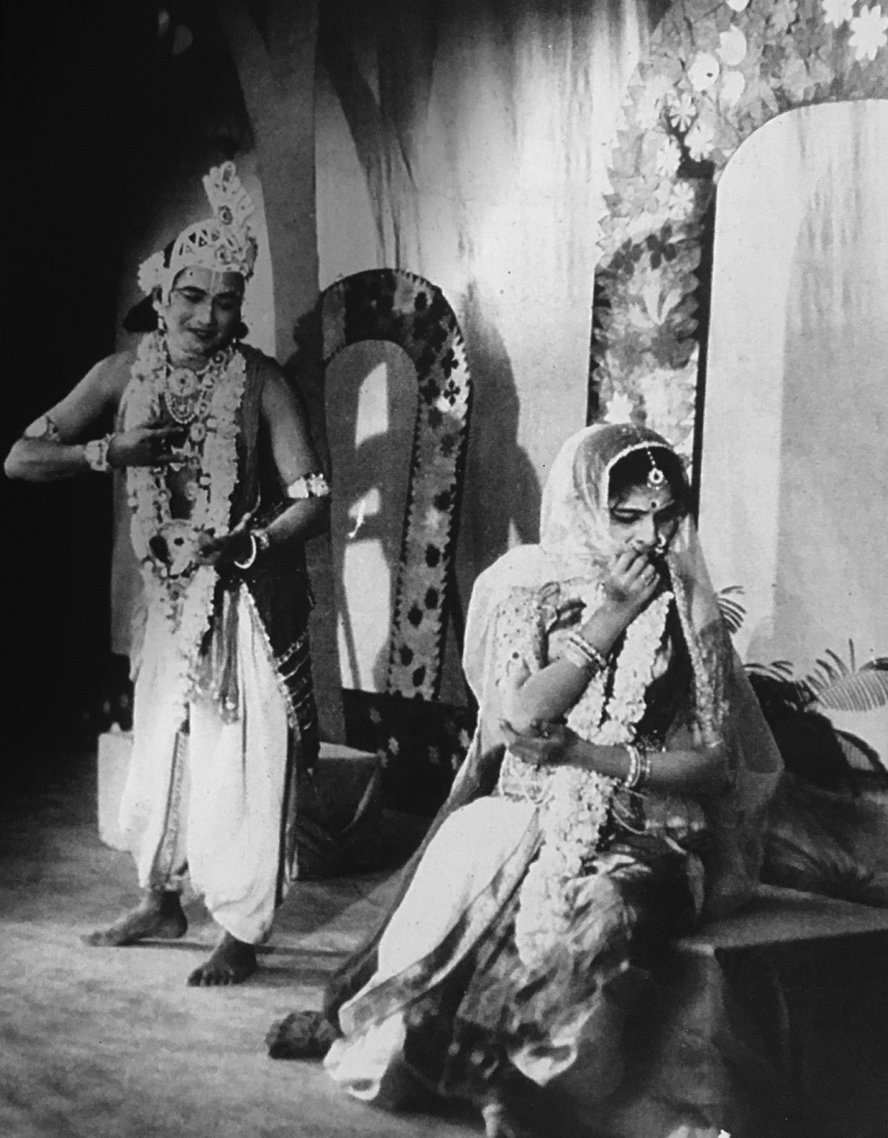 Mayadhar Raut and Sanjukta Panigrahi in Geeta Govinda (1963) (courtesy Guru Mayadhar Raut collection) Among all the gurus, the ones who first attempted the compositions of the ashtapadi of Geeta Govinda were Mayadhar Raut and Kelucharan Mohapatra. In the first phase, in the early sixties, the ashtapadi started to be composed in a linear and more simple way, adhering to the literal meaning of the words of the poems without trying to add any amplification. After the Dashavatar, the next song of the Geeta Govinda to be composed as a solo dance has been the 3rd song of the poem 'Lalita lavanga lata parisilana komala malaya samire' ('Soft sandal mountain winds caress the quivering vines of clove'), a hymn to the spring season introducing the dance of Krishna along with the gopis in the forest of Vrindavan. This was first danced by Sanjukta Panigrahi in January 1958 on the occasion of the All India Dance seminar held during the 31st Conference of the Music Academy at Chennai. She was accompanied by Kelucharan Mohapatra on the mardala and Balakrishna Das as the vocalist while Kalicharan Patnaik read his paper on the historical and practical aspects of Odissi. It was again with Sanjukta that Kelucharan Mohapatra composed the first version of the 17th song of the poem 'Yahi Madhava yahi Keshava ma vada kaitava vadam' ('Go away Madhava, go away Keshava, don't tell your lies to me'). The composition at this stage did not include the mischievous responses of Krishna trying to defend himself from Radha's accusations on seeing the marks left by the other woman on his body or her expressions of anger and frustration for having made in vain all the preparations for their meeting. Similarly, the first version of the two ashtapadi composed by Kelucharan for Priyambada Mohanty for her performance at Delhi in 1961 organized by The Little Theatre Group at Sapru House, the 13th song, 'Yami he kam iha saranam' ('Whom can I seek for refuge here') and the 12th one 'Pashyati dishi dishi rahasi bhavantam' ('In her loneliness she sees you everywhere') were for the time being just linear interpretations of the poetry, interspersed with repetitions of the same line rendered by different mudras but not yet amplified by the inclusion of sanchari or enlarged interpolations. The introduction of the sanchari bhava or auxiliary situations meant to reinforce and sustain the principal emotion (sthayee bhava) expressed in a particular song, happened gradually along with the increasing of the dancers' maturity and of the masters' confidence and experience as composers. It is difficult to ascertain with absolute certainty when and who introduced the use of amplification and dramatization in the first compositions of the ashtapadi during this formative phase of the Odissi repertoire. The exposure of Mayadhar to the abhinaya compositions in Bharatanatyam style, a style which had started to be revived much before the Odissi one and had a more uninterrupted lineage of composers and performers in its past history, have certainly played a role in it. On the other hand, Odia literature was supplying enough material in terms of anecdotes and colourful stories about the Radha Krishna theme to be utilized for imaginative and creative interpolations. The vast literature on the subject belongs to the centuries subsequent to the time in which the Geeta Govinda was composed, and the amplifications inserted in the stories are the fruits of the imagination of the innumerable poets who dealt with it. The first staging of the Geeta Govinda as a dance drama by the Kala Vikash Kendra happened in 1963, and had Mayadhar in the role of Krishna and Sanjukta as Radha with choreography by Kelucharan Mohapatra. The close collaboration of these two gurus in the dance compositions of the Kendra during the first half of the sixties resulted in a reciprocal enrichment of their creative potentialities. The staging of the dance drama may have contributed to the subsequent output of solo compositions which followed afterwards. Each of the songs presented in shorter version in the dance drama and interpreted by different dancers started to be re-elaborated and expanded as solo versions where the solo dancer would act all the characters by portraying appropriate actions and expressions for each of them. From this time onwards, the first two ashtapadi which had been composed-Lalita lavanga lata parisilana and Pashyati dishi dishi-became part of the syllabus taught to the senior students at the Kala Vikash Kendra along with the basic concepts of nayika-nayaka, rasa and bhava according to the shastric definitions. The time was just ripe for the burst of creativity which followed and each of the pioneer gurus were ready to follow their individual path for the common goal of enriching and establishing the newly recomposed Odissi style on the world map. While Pankaj Charan Das and Deba Prasad Das preferred to concentrate more on abhinaya compositions from Odia literature it was Kelucharan Mohapatra who became permanently associated with the compositions as well as the renditions of the ashtapadi from the Geeta Govinda. SEMINAR ON JAYADEVA At the award function of the Central Sangeet Natak Akademi in January 1967, Kelucharan Mohapatra did not dance himself but accompanied on the pakhawaj his most gifted student, Sanjukta Panigrahi. Sanjukta, on that occasion danced the Batu and Pashyati dishi dishi accompanied on vocal by Balakrishna Das. The ashtapadi by now had been enriched by further sanchari and the first line of the poem had to be repeated fourteen times to accommodate all the different actions of Radha's feverish imagination. 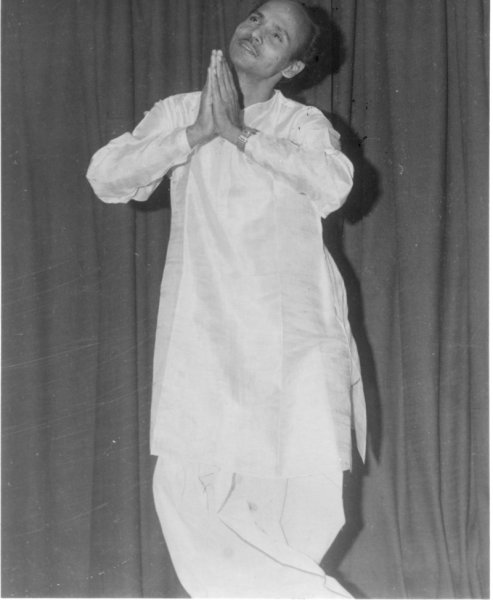 Kelucharan Mohapatra in Jayadeva Seminar 1967 (courtesy Sangeet Natak Akademi) In the same year 1967, in the month of March, a major event was held in Delhi, a national seminar on Geeta Govinda, jointly organized by the Sangeet Natak Akademi and the Lalit Kala Akademi. Kalicharan Patnaik was invited to present a paper on Geeta Govinda in Odissi dance and Kelucharan Mohapatra was to present the dance rendition of the ashtapadi. For the occasion two new ashtapadi were composed by him in Kumkum Mohanty's house, the 11th song 'Dhira samire Yamuna tire vasati vane vana mali' ('With a gentle wind, on the bank of the Yamuna, the one with a wild flowers garland dwells in the forest') and the 6th song 'Sakhi he kesi mathanam udaram' ('Oh friend, bring the killer of the demon Kesi to revel with me') both with music by Pandit Bhubaneswar Mishra. Besides these two ashtapadi, Kumkum was also taught 'Lalita lavanga lata parisilana' and 'Pashyati dishi dishi' which had been previously composed. The exposition of these four abhinaya in the graceful and lyrical Odissi style, conquered the hearts of the public attending the seminar and earned the title of 'little Padmavati' to Kumkum who was appreciated for the spontaneity and childlike quality of her rendering. In spite of the success of the presentation, the next day a daily newspaper reported about some adverse comments by Rukmini Devi Arundale in reference to the 'vulgarity' of the items presented and to the fact that, according to her, such explicit allusions of an erotic nature should not be portrayed in dance. A couple of years later, in February 1969, when Sonal Mansingh, who had started learning from Kelucharan Mohapatra since 1965, was invited to give a series of performances for the different sabhas in Madras, Rukmini witnessed the first performance at the Museum Theatre. On this occasion Sonal performed the 24th song of the poem, 'Kuru yadunandana chandana sisiratarena karena payodhare' ('Yadava hero, your hand is cooler than sandal on my breast'), which had been composed in Cuttack with her in 1967. Rukmini was finally won over; not only did she not see any vulgarity in the dance composition but was full of praise for both the dancer and the guru. She found the interpretation totally faithful to the lyric with a high degree of aesthetic sensibility.  Kelucharan Mohapatra in Kuru yadunandana (Photo: Ileana Citaristi) The 24th song eventually is the one which more than others remains associated with Kelucharan Mohapatra's name not only as a landmark in his repertoire but above all, for the exquisite brilliance of his own interpretations on stage. No one among his female students could ever match the dignified grace and elegance and the intensity of passion which he was able to portray through this abhinaya. He performed this ashtapadi also on the occasion of the Seminar-cum-Exhibition on Sri Jayadeva and Geeta Govinda organized by the Department of Culture, Government of Odisha, at Bhubaneswar in April 1984. The Guru kept on re-composing and re-chiselling the compositions of this ashtapadi along the years while teaching the subsequent batch of dancers. In the late 1960s, he continued to work also on another ashtapadi, 'Yahi Madhava yahi Keshava mavada kaitava vadam', which had already been composed with Sanjukta in the early 1960s. This is another major composition which would continue to be re-elaborated by him until the eighties. While the first edition of the poem was devoid of any amplification, in the newly expanded version, Krishna's replies to Radha's accusations are introduced without distracting from the main bhava or emotional status of Radha who, having been deceived (vipralabdha nayika) is feeling hurt and enraged against her lover (khandita nayika). All through the composition not only Krishna's behaviour is subdued but also Radha's refusal of him is portrayed in a dignified and controlled manner befitting her classification as uttama nayika (heroine belonging to the higher social status). 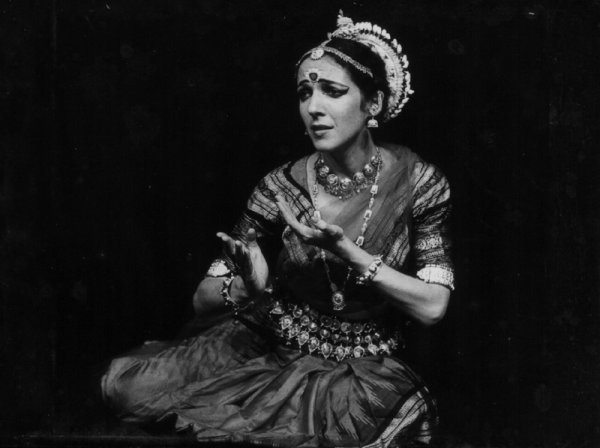 Ileana in Yahi Madhava ashtapadi (Photo: Sebastiana Papa) The 13th song of the poem 'Yami he kam iha saranam sakhi jana vacana vancita' ('To whom shall I, deceived by the words of my friend, go for refuge') which had been composed in a short version for Priyambada Mohanty in 1961 was totally re-composed by Kelucharan Mohapatra for his senior students Kumkum Lal and Madhavi Mudgal in Delhi in the late seventies. Although this composition does not contain thematic expansions in terms of additional concurrent situations, it does include an interesting elaboration on the theme of the pushpa bana pancha or five flowers arrows attributed to god Kamadev. The first line of the 8th pada of the song 'kusuma sukumara tanum atanu sara lilaya' (the graceful arrows of the God of Love play on my delicate body') refers to the effects caused by the piercing of the love arrows on Radha's fragile body. To each repetition of the line, a different flower is depicted with the respective effect attributed to it by the classical scriptures. The white lotus (aravinda) produces delight (harsana), the blue one (nilautpala) desire (rochana), the flower of the ashoka tree excites passion (mohana), the small white flowers of the mango tree (choota) provokes withering (sasana) and finally the white jasmine (navamallika) leads to death (marana). During the process of the composition, the meaning of the song was explained to Kelucharan by Jivan Pani, a poet, writer and Sanskrit scholar all in one, with a vast knowledge of scriptures, literature and mythology. The collaboration between these two creative artistes resulted in this carefully chiselled dance choreography which is faithful to the literal Sanskrit meaning and at the same time is aesthetically rich and poetical. The 19th song 'Priye charu sile munca mahi manam anidam' ('Radha, my cherished love, abandon your baseless pride') carries a particular strong emotional appeal with the audience because it contained the climatic act of surrender of Krishna to his faithful beloved Radha in the line 'smara garala khandanam mama sirasi mandanam dehi pada pallavam udaram' ('place the noble sprout of your foot as an ornament upon my head to dispel the poison of love'). When Kelucharan Mohapatra started again to perform on stage from the eighties onwards along with his outstanding interpretations of Radha's character, he retained for himself also the personification of Krishna in this particular ashtapadi, which he danced either as a solo or in duet with one of his senior female students. The composition has a sort of gradual intensification of emotional intensity and builds up its way towards the climax with images which become increasingly more and more poignant. Among the other noteworthy compositions by Guru Kelucharan are the numerous pallavi composed by him in collaboration with Pandit Bhubaneswar Mishra. The most popular are the ones in raga Shankarabharanam and Saveri (1967), Arabhi (1968), Bhageshree (1971), Khamaj and Hamsadwani (1979), Belahari (1983) and Kirwani (1986). Guru Deba Prasad Das has composed a myriad of abhinaya to traditional Odia songs belonging to medieval Odia literature maintaining the traditional flavour without adding any sanchari and adhering strictly to the predominant bhava of the lyrics. Among his most popular items are the thai-nata and pallavi in raga Kalyani, Basanta and Kalavati. His extensive research in the folk forms of Odisha reflects in his compositions and in the use of the sabda-swara-pata (melodic recitation of rhythmic words mostly attributed to different Gods) in most of his items. He has left behind a manuscript Nrutyanusarani depicting the technical aspect of the dance illustrated by sketches of the various components drawn by himself. Guru Pankaj Charan Das's repertoire includes compositions on Odia lyrics as well as epic subjects. He has incorporated bandha-nrutya (acrobatic poses) and thali-nrutya (dance on a tray) in some of his compositions which were supposed to belong to the traditional mahari repertoire. Some very interesting and unique creations are the gatibilasa pallavi, an item of nritta composed on the different animal steps, the panchakanya abhinaya dealing with the five women characters Ahalya, Draupadi, Kunti, Tara and Mandodari from the epic literature and glani-samhara, based on the Odia version of the dashavatar myth. He mostly composed his items in collaboration with musicians Harihar Panda and Balakrishna Das. Sources - Citaristi, I., The Making of a Guru: Kelucharan Mohapatra-His Life and Times, New Delhi, Manohar, 2001. - Citaristi, I., (editor), 'Jayantika', Nartanam (special volume) vol. XVIII, no. 3, July-September 2018, p. 155, Odia original proceedings of Jayantika meetings (translated by Malabika Patel). - Citaristi, I., Odissi and the Geeta Govinda, New Delhi, Manohar, 2022 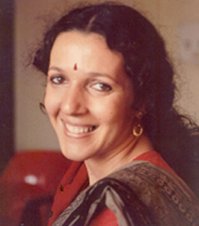 Dr. Ileana Citaristi is an Italian born dancer, who trained under Guru Kelucharan Mohapatra in Odissi and under Guru Hari Nayak in Mayurbhanj Chhau. She founded Art Vision in 1995 in Bhubaneswar. She has authored 'The making of a Guru' on Kelucharan Mohapatra, 'My Journey: A Tale of Two Births', Traditional Martial Practices in Odisha.' Post your comments Pl provide your name and email id along with your comment. All appropriate comments posted with name and email id in the blog will be featured in the site. |